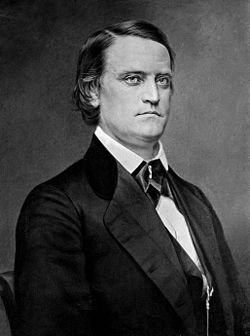| 36th United States Congress | |
|---|---|
35th ← → 37th | |
 United States Capitol (1860) | |
March 4, 1859 – March 4, 1861 | |
| Members | 66 senators 238 representatives 5 non-voting delegates |
| Senate majority | Democratic (until February 4, 1861) Republican (from February 4, 1861) |
| Senate President | John C. Breckinridge (D) |
| House majority | Republican-led coalition |
| House Speaker | William Pennington (R) |
| Sessions | |
| Special [a] : March 4, 1859 – March 10, 1859 1st: December 5, 1859 – June 26, 1860 Special [b] : June 26, 1860 – June 28, 1860 2nd: December 3, 1860 – March 4, 1861 | |
The 36th United States Congress was a meeting of the legislative branch of the United States federal government, consisting of the United States Senate and the United States House of Representatives. It met in Washington, D.C. from March 4, 1859, to March 4, 1861, during the third and fourth years of James Buchanan's presidency. The apportionment of seats in the House of Representatives was based on the 1850 United States census. The Senate had a Democratic majority, and the House had a Republican plurality.
Contents
- Major events
- Major legislation
- Constitutional amendments
- Treaties
- States admitted and territories organized
- Party summary
- Senate
- House of Representatives
- Leadership
- Senate 2
- House of Representatives 2
- Members
- Senate 3
- House of Representatives 3
- Changes in membership
- Senate 4
- House of Representatives 4
- Committees
- Senate 5
- House of Representatives 5
- Joint committees
- Caucuses
- Employees
- Legislative branch agency directors
- Senate 6
- House of Representatives 6
- See also
- Notes
- References
- References 2
- External links











